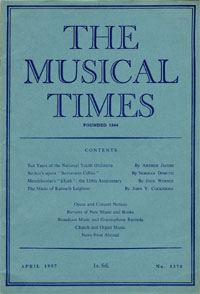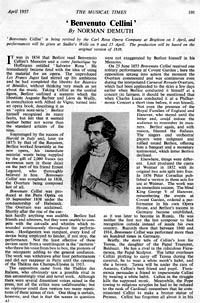
Benvenuto Cellini
by
Norman Demuth
© 1967-2011 Norman Demuth
Published in


|
Benvenuto Celliniby Norman Demuth © 1967-2011 Norman Demuth Published in |
 |
‘Benvenuto Cellini’ is being revived by the Carl Rosa Opera Company at Brighton on 5 April, and performances will be given at Sadler’s Wells on 9 and 15 April. The production will be based on the original version of 1838.
![]() T was in 1834 that Berlioz read Benvenuto Cellini’s Memoirs and a conte
fantastique by Hoffmann entitled ‘Salvator Rosa’. He immediately
became fired with the idea of using the material for an opera. The
unproduced Les Francs Juges had stirred up his ambitions and he had
completed the libretto for Béatrice et Bénédict, without
thinking very much as yet about the music. Taking Cellini as the central
figure, Berlioz outlined a scenario which the librettists Auguste Barbier
and Léon de Wailly, in consultation with Alfred de Vigny, turned into an
opera book, describing it as an ‘opéra semi-séria’. Berlioz himself
recognized its many faults, but felt that it seemed neither better nor
worse than the standard articles of the time.
T was in 1834 that Berlioz read Benvenuto Cellini’s Memoirs and a conte
fantastique by Hoffmann entitled ‘Salvator Rosa’. He immediately
became fired with the idea of using the material for an opera. The
unproduced Les Francs Juges had stirred up his ambitions and he had
completed the libretto for Béatrice et Bénédict, without
thinking very much as yet about the music. Taking Cellini as the central
figure, Berlioz outlined a scenario which the librettists Auguste Barbier
and Léon de Wailly, in consultation with Alfred de Vigny, turned into an
opera book, describing it as an ‘opéra semi-séria’. Berlioz himself
recognized its many faults, but felt that it seemed neither better nor
worse than the standard articles of the time.
Encouraged by the success of Harold in Italy and, later (in 1837) by that of the Requiem, Berlioz worked feverishiy at the new opera, his immediate material wants being supplied by the gift of 2,000 francs (an enormous sum in those days) on the part of his friend Ernest Legouvé, who thoroughly believed in him. Benvenuto Cellini was completed in 1838, the Overture being composed last of all.
Benvenuto Cellini was produced at the Paris Opéra on 10 September 1838 under the conductorship of Habeneck. The Overture was acclaimed. Shortly after the rise of the curtain hardly anything was audible. Berlioz had friends and admirers, but they were unable to compete with the cat-calls and whistles which resounded continuously throughout the performance. Hooliganism was rampant, every kind of device being employed to hinder, if not stop, the performance. Not the least effective of these devices came from a ventriloquist in the ‘parterre’ who threw his voice from box to box, the protests of the occupants adding to the general confusion. The work was withdrawn after four performances and did not reappear in Paris until the opening of the Théâtre des Champs Elysées in 1913.
The opposition came from the Théâtre des Italiens, who obviously saw a possible rival in this astonishingly vital and novel work. Although there were several dissentient voices raised in the press, not all the critics were unfavourable; but no régisseur could dare venture too many repetitions of these scenes of riot. One thing is certain, however, and that is that the scenes in question were not exaggerated by Berlioz himself in his Memoirs.
On 25 June 1853 Benvenuto Cellini received one solitary performance at Covent Garden; here the opposition sprang into action the moment the Overture commenced and was continuous even during the interpolated Carnaval Romain Overture, which had been applauded to the skies a few days earlier when Berlioz conducted it himself at a concert (in fairness, it should be mentioned that when Charles Lucas conducted it at a Philharmonic Concert a short time before, it was hissed). Not even the presence of the Royal Families of England and Hanover, who stayed until the bitter end, could induce the audience to remember its manners. Berlioz again, and with reason, blamed the Italians. The singers and orchestral players were indignant and rallied round Berlioz, offering him a banquet and a monetary testimonial, which latter Berlioz declined.
Elsewhere, things were different. Liszt produced the opera at Weimar in 1852 with its original two acts split into four. In 1856 Peter Cornelius published a version in three acts for use at Weimar. The work was an immediate success. The blind King George V of Hanover, remembering the events at Covent Garden, ordered a performance in his own Opera House, and Berlioz’s success in Germany became established, as it was later to become in Russia. He was neither the first nor the last composer to find recognition outside instead of inside his own country. Records show that between 1860 and 1914, Benvenuto Cellini was performed more than six hundred times in Germany.
Briefly, the story tells of Cellini’s love for Teresa, the daughter of the Papal Treasurer, Balducci. He has a rival in the ridiculous Fieramosca, the Papal Sculptor. The latter overhears Cellini plotting to carry off Teresa during the carnival, he to wear a white monk’s habit, and she a brown. Teresa will be under the care of Ascanio, Cellini’s best friend and pupil. Fieramosca persuades a friend to impersonate Cellini by wearing a white habit. Cellini in the struggle kills the supposed monk. Meanwhile, the Pope (owing to religious scruples he had to be reduced to the rank of Cardinal) remembers that he commissioned Cellini to make a bronze statue of Perseus. Cellini has forgotten all about it in his anxiety to capture Teresa. The Cardinal threatens to give the casting of the statue to someone else. Cellini, in turn, threatens to break the model rather than that it should be cast, even by Michelangelo. The Cardinal, struck with this creative integrity, gives Cellini the alternative of casting the statue or of being hanged for murder, and a limited time is allowed for the completion of the work. Cellini throws all his priceless metal statues and figures into the furnace, and in this he is supported by his team of workers. Needless to say, all goes well in the end.
The book is full of absurdities. However, I cannot see that, in view of the scenes of riot and confusion, the poor quality of the libretto could have made any difference at all, and it is only later awareness of its failings and the hitherto undetermined assessment of Berlioz as a composer and important figure which have militated against the work. Now that Berlioz is recognized for what he was and is, Benvenuto Cellini need be criticized no longer as an opera weighed down by its unfortunate libretto. It has, in fact, like its composer, become a classic in spite of faults.
If the opera is approached in the light of an historical landmark, there is no reason why Benvenuto Cellini should not take its rightful place in the repertory. It may be said with truth that Berlioz’s music transcends the libretto. Berlioz has now found his rightful niche.
Realization of his significance and a clearer understanding of his personality have now dawned, even though there are still some doubters. Benvenuto Cellini is a more important work than many which hold their positions in the repertory. Restitution, therefore, is on the way.
![]()
* We have transcribed the text of this article from
the 1 April 1957 issue of The Musical Times, a copy of which is in our collection. We have not been able to contact the descendants of the late Norman Demuth or the editor of The Musical Times.![]()
![]()
The Hector Berlioz Website was created by Monir Tayeb and Michel Austin on 18 July 1997; this page created on 11 December 2011.
© Monir Tayeb and Michel Austin. All rights of reproduction reserved.
![]() Back to Original Contributions page
Back to Original Contributions page
![]() Back to Home Page
Back to Home Page
![]() Retour à la page Contributions Originales
Retour à la page Contributions Originales
![]() Retour à la Page d’accueil
Retour à la Page d’accueil